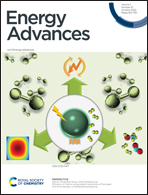A metal-free reduced graphene oxide coupled covalent imine network as an anode material for lithium-ion batteries†
Abstract
Organic electrodes for batteries have been receiving tremendous impetus in the recent past for sustainable development. A metal-free crystalline and porous covalent imine network (Tp-THzT-CIN) has been synthesized via solvothermal Schiff-base condensation between a trialdehyde (Tp) and a triamine (THzT). This network is laden with lithium ion exchange sites, accessible open pores, high specific surface area and the presence of heteroatoms that enable lithium ions to intercalate into the pores. When explored as an anode material for lithium ion batteries it exhibits a specific capacity of 82 mA h g−1 at a current density of 50 mA g−1. Interestingly, when this CIN material is coupled with reduced graphene oxide (rGO), its efficiency has been enhanced many fold and it exhibits a specific capacity of 123 mA h g−1 at a current density of 50 mA g−1.

- This article is part of the themed collection: Lithium ion batteries – Topic Highlight


 Please wait while we load your content...
Please wait while we load your content...